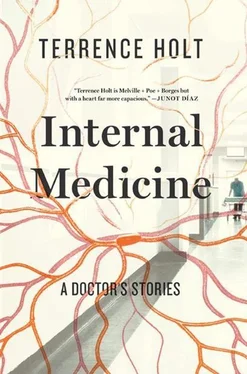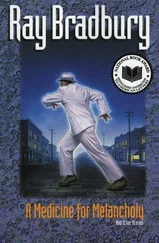Linda reached across the table. “She still does.”
He did not look up. “I don’t know,” he said quietly. When he looked up again, it was to study the wall. “I don’t know what I’m going to do with these.”
“YOU DID GOOD IN there,” Linda said as the farmhouse receded behind us.
I stared at her. Was she joking?
When I did not respond, she gave me a sidelong glance. “Bringing up those church ladies,” she explained.
Had I done that? How that had helped anything I could not begin to fathom.
“All I did was make her cry,” I said.
“Exactly.”
I puzzled over this until she added impatiently, “We’re hospice. ”
“Oh.”
“She’s dying: she needs to cry.” The tires thumped and she pulled the car abruptly onto the shoulder. “ He needs to cry.” She stared meditatively out the windshield. “I’m not sure I want to be around when he does.”
“Ah,” I said.
Another sidelong glance. “ ‘ Ah? ’ Are you getting this?”
“Oh, yeah,” I said. “I get it.”
She stared at me flatly for a long moment, until I grew embarrassed and turned to look out the window.
WHEN MY SON WAS not quite four, he had drawn a picture that was supposed to represent a spleen, a swarm of red and purple dots he had copied laboriously from a textbook on histology. His teacher had been so charmed by the description (“spleen, mag 240x”) that she had taken it off that afternoon to an art show put on by the hospital, children’s drawings meant to brighten the lobby. From which it had never, tragically, returned. The disbelief, then anger, and finally inconsolable sorrow, had lasted the better part of a week. They still resurfaced months later, a muted echo wistfully raised at odd moments, from the back seat of the car, or twenty minutes after bedtime, to which my own and my wife’s helpless response had become almost automatic. But we also felt a trace of that same sorrow, not so much from the loss as our helplessness in the face of it.
My sleep that night was broken repeatedly by that helplessness — dreams, fragments of nightmares in which lost things cried plaintively out of the dark. But when I went to find them there were only drawings of whatever it was I so urgently sought: crude, parodic cartoons, mocking my deep need. And even as I held each crumpled bit of drawing paper, the voice kept crying, somewhere else.
LEAVING U.S. I, WE descended into a wilderness of wooded hollows, surfacing into small clearings of abandoned tobacco holdings, then woods again, until we stopped in a crunch of gravel. A small cabin perched at the edge of a four- or five-acre clearing, much of it fallow and ragged with early weeds, but around the house a neat plot of fescue lay smooth and emerald green. The cabin looked vaguely like a chalet, the clapboard siding pine under varnish. Inside, the walls and kitchen cupboards were all the same yellow pine, shining dully in the morning light. The front room was dominated by a large picture window, and directly beneath it a low single bed, on which lay a man who might have been sleeping, but his eyes were open, fixed on the view outside. He gave no sign that he heard us enter, ushered in by a small woman in a brilliant purple dress. She brought us back into the kitchen, where she steered us to the long pine table.
On the wall by the sink a framed rotogravure showed Jesus on his knees, praying beneath a lowering purple sky. Facing Jesus from the other side of the sink was a yellow sunflower woven from colored straw. It bore the rubric, Every day is a sunny day somewhere . The image of Jesus did not bear this out.
“Doctor?”
The woman was looking at me, evidently waiting for a response. Off to one side I saw Linda looking amused.
“I’m sorry,” I said. “I didn’t catch that.”
“That’s all right, Doctor,” the old woman said. “You’ve always got a lot on your mind, I know.” She settled herself in the other chair. “I was just saying it was so good of you to come.”
There was something here, as well, that seemed to be saying more than I could grasp. She sounded almost as if I had been here before and she had been expecting me to return. I looked around the room, half hoping to find some clue, but the more I looked about the kitchen, the more firmly it refused recognition.
Until my gaze fell on the refrigerator, where, among snapshots of a diverse assortment of young people, half of whom had been caught in the process of graduating from middle school, I saw a sheet of bright yellow paper (the same shade as the sunflower still trying to cheer up Jesus by the sink) headed with a red stop sign: a standard out-of-hospital DNR form. There, at the bottom of the form, was printed my own name, and below it my illegible, unmistakable signature. I had met this woman before. And the passive figure lying out in the front room: I knew him now. Terminal heart failure, discharged to home with hospice. I had taken care of him in the hospital two or three months before. Alston: the name came back to me at last.
I cleared my throat. “How is he?” I said.
The woman looked into the front room, intent for a long moment on the figure on the bed. Then she looked back at me.
“He’s not good, Doctor.” Her voice was flat, her expression unreadable.
Finding myself here, so unexpectedly, in a home I had never thought to enter (one of the inescapable facts of hospital medicine is that, upon discharge, a patient vanishes from sight), I felt as if my presence here was a falsehood. This woman thought I had come to see how her husband was. She thought I had remembered him.
How many patients had I discharged this way, I wondered, patients I knew were going home to die, and never had a moment to think of again? I couldn’t begin to guess, no more than I could count all the others who had died in-house: for a long moment I saw a flickering of images like a primitive newsreel: not their faces, not their names, just shapes in beds. I could remember much better the rooms in which they had spent their final hours, sometimes multiple ghosts inhabiting the same room: their rooms, their diagnoses, and sometimes (these were the worst), when I could remember faces, it was only how they had looked when I had come into the room to pronounce them dead: the blank mask where before had been a personality.
I looked around at the bright, spotless kitchen, the woman’s face across the table still expressionless, and my presence in this house seemed the inevitable outcome of all those unthinking discharges: I was here to expiate some sin of omission.
I had just begun to contemplate how little I knew about the expiation of sin when Mrs. Alston shook her head.
“He’s not good, Doctor,” she said again. Then, dropping her voice, in a tone that combined urgency and grief: “Why didn’t anyone tell us what it would be like?”
I felt a stab of guilt.
Linda was at her shoulder, murmuring something I couldn’t catch. Looking over the woman’s head at me, she gestured toward the front room: “Go see Mr. Alston,” she said. I rose and left the kitchen, relieved to be anywhere else.
The figure on the bed shifted as I came in. Mr. Alston’s face seemed inscrutable at a distance, but as I approached and the eyes followed me, I recognized what it held: the utter weariness of a man whose heart had failed. When we had discharged him, he had been too weak to lift himself from his bed; if I had thought about it I would have given him only a week or two. But he was still here, his heart still feebly beating, the chest still rising and falling, the minutes continuing to pass and each day following the last into the night. He watched as I approached, as impassively as I imagined he watched for Death itself, because his life had narrowed down to this: watching or not. The eyes followed my approach, but beyond registering my existence they gave away nothing.
Читать дальше












